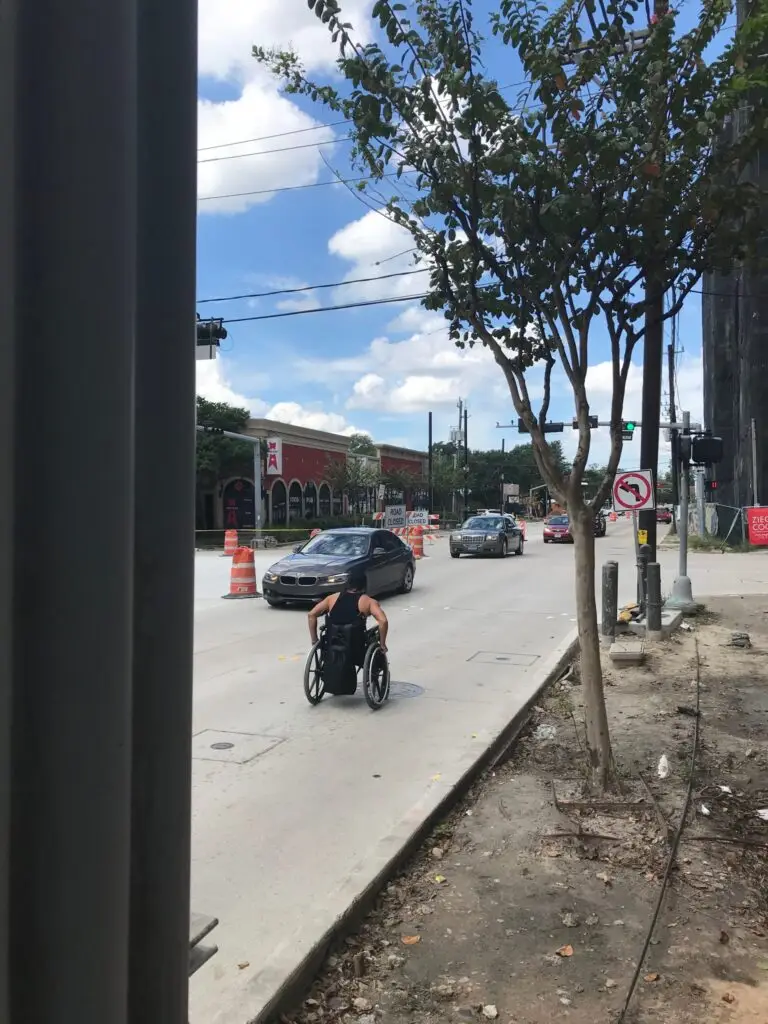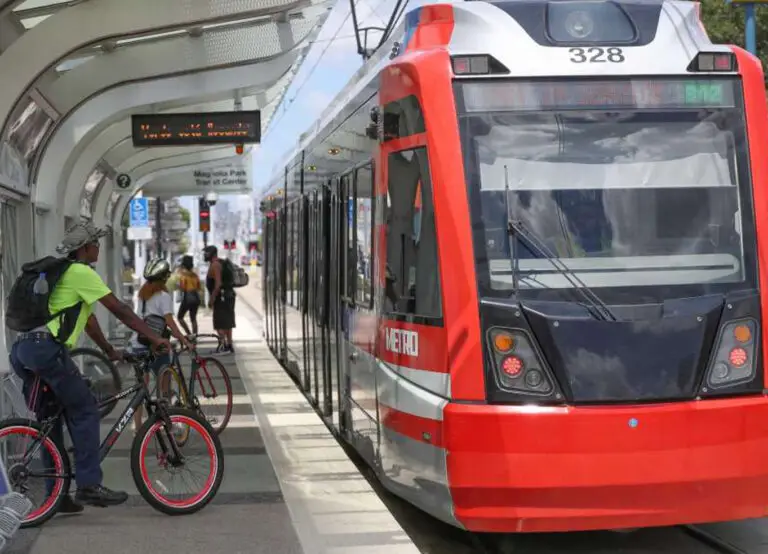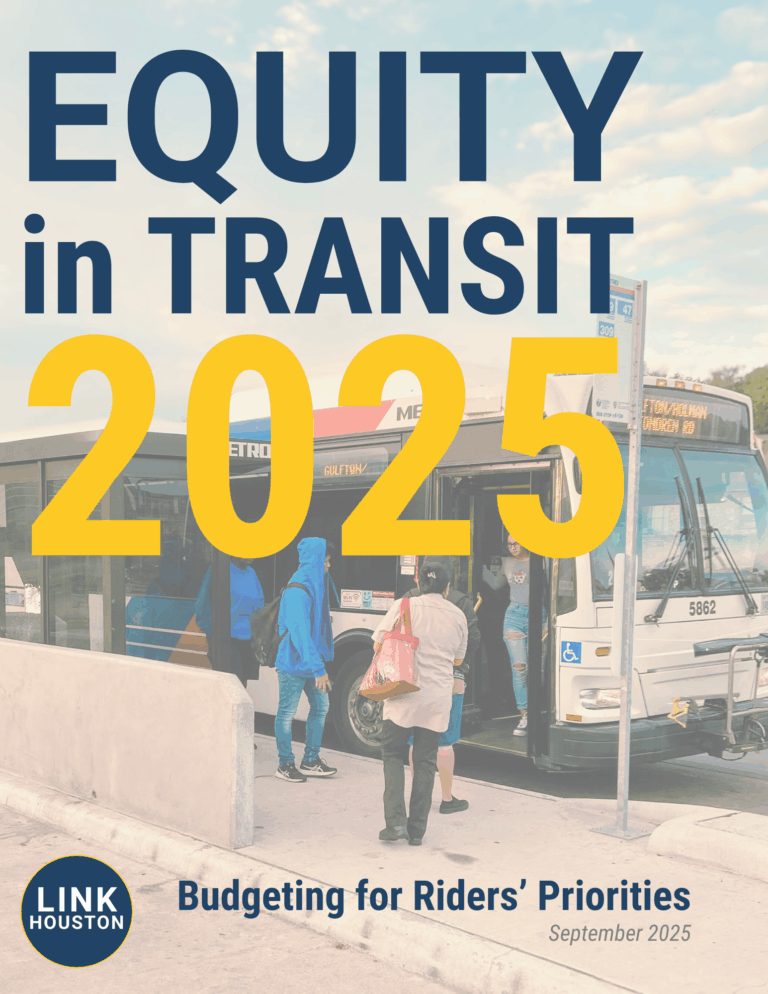LINK Houston – Fee in Lieu Sidewalk Ordinance Amendment Comments – PDF
To the Planning and Development Department – City of Houston
To Whom it May Concern:
LINK Houston views the proposed ordinance amendments to create a sidewalk fund populated with fee-in-lieu funds as one step forward on a continuing journey to improve pedestrian accessibility, safety, and connectivity in Houston. The proposed ordinance amendments to add a fee-in-lieu can be a positive step forward, but they must not be the only steps taken to improve our sidewalk network. We provide the information on the following pages to describe the policy and funding steps needed, as well as the importance of sidewalks for Houston to improve equity, climate justice, and access to opportunity.
We envision a community fabric where all people have the freedom of mobility to access the opportunities their vibrant neighborhoods offer. To make that vision a reality, we support transformative and inclusive policies, systems, initiatives, and infrastructure development that connect people to opportunity by transit, walking, rolling, and biking. An accessible, continuous sidewalk network is essential infrastructure and must be prioritized by the City of Houston as part of Houston’s future.
The LINK Houston staff and board regularly ride transit, bike, walk, and roll as part of our work and personal activities. Sidewalks in Houston too often are in poor condition, or simply do not exist. We have observed many neighborhood and civic club meetings where concerns have been raised about sidewalks – both their condition and safety. As a result of such conversations, we recently partnered with residents of the Second Ward, and volunteers, to audit sidewalk conditions in a section of that community. Within even a small area, we found streets with pristine sidewalks and corner ramps, yet other nearby areas without any sidewalks at all (read our findings in English or Spanish by visiting: http://linkhouston.org/reports-briefings/safesidewalkssecondward).
LINK Houston supports policy changes which can reasonably be expected to improve equity and climate justice. We listened to the City of Houston Planning and Development Director Margaret Wallace Brown’s presentations to the Super Neighborhood Alliance in spring 2022 and last month’s remarks before the Houston Planning Commission on the proposed ordinance amendments concerning sidewalk infrastructure. We also spoke with city staff directly. We understand, and quote, “the main objective of the proposed sidewalk ordinance amendments is to promote a complete sidewalk network in the city by addressing equity and pedestrian accessibility.”[1]
We hope for a better and brighter future for Houston. The sidewalk network is part of that future. We believe the new sidewalk fund will add sorely needed resources and fund completing gaps in the sidewalk network. We expect City of Houston staff and elected officials to equitably develop and implement the Sidewalk Prioritization Scoring Matrix.
Houston Must Keep Taking Steps on Sidewalks
LINK Houston looks for fairness in the application of the ordinance on the fee payers…and then equity (i.e., strategic implementation) in the use of the funds. We also look for the City of Houston, and partners, to continue taking steps on sidewalks. The following six ideas will help.
New Funds from Fee-in-lieu Must Not Supplant Existing Program Funds
The City of Houston’s three existing sidewalk programs[2] receive minimal resources. The Pedestrian Accessibility Review process, the most active of the three programs, had a multi-year backlog until recently – thanks to Mayor Turner, city councilmembers, and their respective staff. Those programs should be a higher budget priority. The Sidewalk Fund from the fee-in-lieu must not supplant existing programs, now or in the future. The 30% of the total must be used to expand the network in locations where people walk from residences to access services and destinations.
Sidewalk Maintenance Needed
We want more and better sidewalks. This includes maintenance, which we understand is not part of the proposed changes. We don’t believe sidewalks in poor condition functionally exist, certainly they do not exist for anyone needing a level surface free of vegetation. City of Houston should identify funds, staffing, and equipment to maintain the sidewalks resulting from the sidewalk programs and the fee-in-lieu supported fund.
Inventory and Master Plan Needed
City of Houston should create and maintain an inventory of sidewalk existence and condition. We are aware of and support the City’s present work on a Houston Resilient Sidewalks Plan. The inventory can inform the City’s refinement and implementation of a sidewalk master plan.
Reduced Parking Requirements Needed
A better sidewalk network will enable Houstonians to access destinations by walking, rolling, and riding transit. People choosing to travel those ways should not be forced to subsidize people who choose to own, operate, and park vehicles. Reducing or eliminating parking requirements is another tool. The Climate Action Plan and Resilient Houston both discuss enabling more property owners to create accessory dwelling units (ADUs) and reducing or eliminating parking requirements, to address both climate change and affordability inequity. Reducing parking for ADUs is big deal, let the market decide and let people find ways add housing stock while protecting their ability to continue affording their property.
Safe Routes to Schools Needed
K-12 students need safe routes and accessibility to their schools. The public must bring to bear every possible tool, funding source, and strategy to create safe, reliable access to school. The sidewalk network and safe intersections are crucial. We also call on school districts to proactively see to student safety. Districts can establish and implement broad policies to identify hazardous traffic conditions and risk of violence and then take measures. Crossing guards can facilitate crossing some collector and arterial streets where crosswalks exist. State-reimbursed bus services can transport students living within two miles of school but who face unsafe conditions not otherwise addressable. The murder of a student in Near Northside in Houston was the springboard for the Texas Legislature to add “high risk of violence”[3] walking areas to state policy for reimbursable bus service in 2017. We need Houston school districts, especially Houston ISD, to act and lead using the available resources.
Accurate Modeling Needed
The Houston-Galveston Area Council (H-GAC) is the 8-county region’s federally designated metropolitan planning organization. As such, H-GAC runs the regional travel demand model that defines how the region plans to accommodate regionally significant travel needs for people and goods into the future. The model also is required to demonstrate how the region will work its way into attainment of federally required air quality measures for ozone, particulate matter, etc. Why bring this up in a document about sidewalks? The regional model all but ignores any trips not taken in a car. Houston will benefit when transportation planners can accurately model trips not taken due to be virtually taken and trips by people walking or biking. Some federal funds seek to specifically support people’s opportunities to make trips by walking or biking. A model that can demonstrate the value of such trips, albeit for a minority of trips taken, will enable the City of Houston, METRO, and other governments to pursue projects to improve the extent of the sidewalk network. Additionally, a model capable of such nuance will be necessary as more and more services enable people to forego a vehicle trip, such as the robotic delivery services by companies such as Nuro.
Why the Fee-in-Lieu? The Downside
Implementing the new policy comes with some level of risk, which officials and staff will need to monitor and mitigate:
- The fee-in-lieu may unintentionally place an inequitable burden on current homeowners seeking to substantially rebuild or modify their own existing property, either due to elective improvements or rebuilding post-disaster.
- Property owners with open-ditch drainage, especially good for stormwater runoff when maintained, could find themselves bearing high fee-in-lieu due to the cost of sidewalks in such situations.
- The fee-in-lieu funds must not supplant other funds for sidewalks, such as funds in the three existing sidewalk programs[4] and funds from other departments and government entities (e.g., tax increment reinvestment zones, management districts, METRO, and etc.).
- The proposed changes do not alter the legal responsibility of property owners to create and maintain sidewalks but rather alter the allowed variances and fee structure concerning sidewalks during the permitting process for rehabilitation or new construction.
Why the Fee-in-Lieu? The Upside
Some of the reasons we believe the proposed ordinance amendments will improve Houston:
- The sidewalk fee-in-lieu could result in more revenue for sidewalks.
- Reducing parking requirements and enabling more property owners to create ADUs would improve a current resident’s options to continue to afford their home.
- The 15 geographic sectors could mean more developing portions of communities contribute to sidewalk funds available to fill in gaps in other areas experiencing less development, but which possess existing sidewalk network gaps.
- There is precedent for City of Houston to collect funds from a specific area and utilize at least 70% of funds in the origin geographic sector and 30% elsewhere in city limits – an opportunity for equitable, strategic improvements.
- Reducing the number of variances obtained by developers could result in less debate about the burden of factoring sidewalks into development and instead result in simply more sidewalks – sort of competitive equity between developers.
- No fee-in-lieu option for any increase in density on a parcel or for commercial uses; tightened allowed variances to reduce sidewalk construction avoidance and ensure more sidewalks constructed.
Why Sidewalks Matter
The sidewalk network is essential to travel affordably and safely in our city. Many people already walk or roll whether sidewalks or safe paths exist.
- About 21,000 people primarily walked to work in 2019 in Houston.[5]
- About 9% of households, or 75,000 households, did not own a vehicle in 2019.[6]
- Owning a vehicle, or an additional vehicle, is expensive – about $9,282 per year.[7]
- 93% of all local bus or rail trips began and ended with a walk in 2018.[8]
- Approximately 15,000 miles of sidewalks were missing in Houston in 2019.[9]
Creating a more complete sidewalk network in a state of good repair is fundamental to safety and achieving Vision Zero. The City of Houston must prioritize funding the three existing sidewalk programs as well as ensuring that funding exists to maintain current and future infrastructure.
- In 2021, 327 people were killed (106) or seriously injured (221) in crashes while a pedestrian.
- In 2020, 300 people were killed (88) or seriously injured (212) while a pedestrian.
- In 2019, 326 people were killed (90) or seriously injured (236) while a pedestrian.
- Only 1.6% of all crashes involve a pedestrian but of those crashes 28% resulted in serious injuries or death. [10]
Children and youth will benefit substantially from better sidewalks and intersections. Students need to reach school safely to learn. There is much room for improvement.
- The Texas Education Agency (TEA) reimburses a portion of the cost of school bus service for students living two-or-more miles from school. TEA will also reimburse a less portion of the cost for bus service for students living less than two miles from school but who cannot walk safely due to traffic hazards or risk of violence.
- Of the 11 school districts serving Houston, 10 operated a combined 2.9 million miles of bus service during the 2019-2020 school year to transport 81,201 students to school each day due specifically to hazardous conditions.
- Houston ISD was the 1 of these 11 districts with no such bus reported services. [11] We understand from speaking with district staff that Houston ISD will add some hazardous services in the future and seek state reimbursement.
- The Houston ISD Board Policy Manual contains unused policy whereby district staff periodically identify hazardous conditions and plan solutions (e.g., crossing guards, bus services, etc). The following quote is from Policy CNA Student Transportation:
“Within hazardous transportation, hazardous traffic is defined as conditions that may exist where no safe walk path is present and students must walk along or cross a freeway or expressway, an underpass, an overpass or bridge, a major traffic artery, an industrial area, or other comparable condition.”[12]
What Makes a Great Sidewalk and Sidewalk Network?
People certainly enjoy pedestrian realms with wide sidewalks, seating, trees, flowers, and other amenities. The reality is that such environments are expensive and well beyond the reality for most streets in most neighborhoods. A great sidewalk masters the fundamentals by being continuous, level, and wide enough for a person with a disability – and better yet for two people travelling side-by-side. A great sidewalk network is predictable and offers frequent, safe street crossings. We all know Houston weather can be hot, and often unbearable. Streets are part of the stormwater drainage system, which is also important. We hope the sidewalk fund, and future policy changes, will enable the City of Houston and the public to improve the extent of the sidewalk network in practical ways.
Figure 1. Excellent Sidewalks in an Area of Second Ward (credit: Google Street View).
In May 2020, we partnered with Rice University’s Kinder Institute and a broad task force to release Where Affordable Housing and Transportation Meet in Houston. The study included several tools, one of which was the “Housing+Transportation Decisionmaker Scorecard”. The scorecard is an assessment tool to ensure affordable housing exists with affordable transportation options and that both are high-quality. High-quality, affordable transportation near affordable housing enables people to get to the places they need to go regardless of means, ability, or circumstances — such as when someone else needs the family car, the car breaks down or is flooded, or to save money.
- Affordable transportation is high-quality for individuals when it provides geographic access to opportunities and is multimodal, timely, practical, dignified, accessible, safe, and at low cost.
- Affordable transportation is high-quality for neighborhoods when it improves health, the environment, community conditions and advances equity.
[1] Muxian Fang, COH Planning & Development Department, March 2022 – collected in an interview.
[2] e.g., pedestrian accessibility review, school access, and major thoroughfares – www.publicworks.houstontx.gov/sidewalk-program
[3] https://tea.texas.gov/about-tea/news-and-multimedia/correspondence/taa-letters/transportation-for-students-in-hazardous-traffic-and-high-risk-of-violence-areas
[4] e.g., pedestrian accessibility review, school access, and major thoroughfares – www.publicworks.houstontx.gov/sidewalk-program
[5] Table B08301, 2016-2020 5-year Estimates, American Community Survey, U.S. Census Bureau
[6] Table B0801, 2016-2020 5-year Estimates, American Community Survey, U.S. Census Bureau
[7] https://www.aaa.com/autorepair/articles/average-annual-cost-of-new-vehicle-ownership
[8] 2018 Origin-Destination Onboard Survey, METRO & Houston-Galveston Area Council
[9] The ideal ratio is 2 miles of sidewalk per 1 mile of street (a sidewalk on both sides). Houston has approximately 11,085 centerline miles of roadways of any type and ideally should have up to 22,170 miles of sidewalk. In 2019, Houston had 6,316 miles of sidewalk based on Houston-Galveston Area Council sidewalk inventory – meaning about 15,854 miles of sidewalk are missing. In other words, instead of the ideal 2:1 ratio Houston has 0.28:1.
[10] TxDOT Crash Records Information System, accessed on June 14, 2022
[11] Texas Education Agency, Foundation School Program, Transportation Route Services Reports
[12] https://pol.tasb.org/Policy/Download/592?filename=CNA3(REGULATION).pdf





